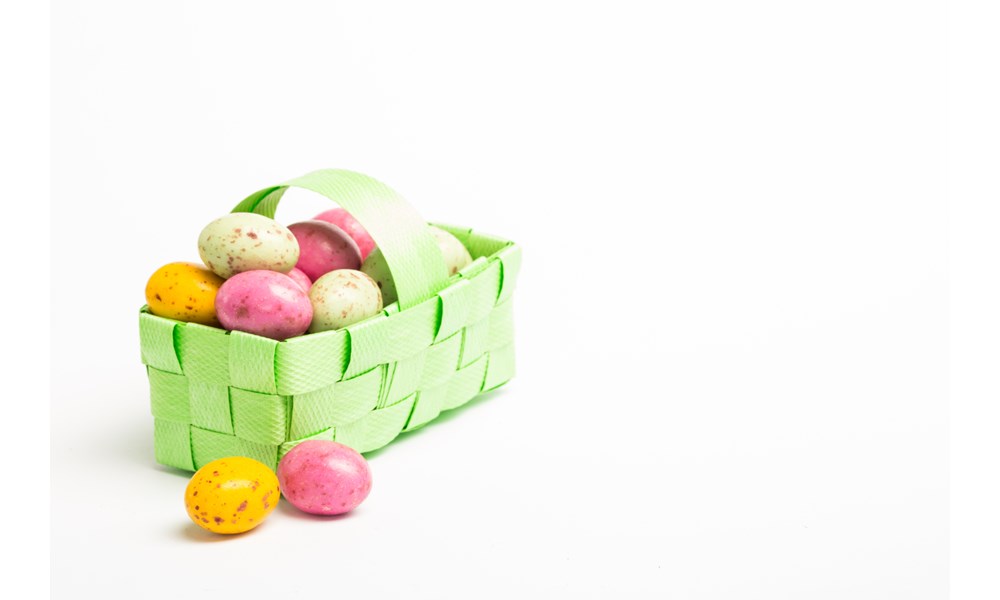
In addition to religious celebrations that coincide with Easter, millions around the world use the first Sunday following the full moon that occurs on or following the spring equinox to gorge themselves with chocolate bunnies, jelly beans, and hard-boiled eggs. These fun facts about Easter demonstrate just how big the celebration can get.
Q: How many chocolate bunnies are eaten each Easter?
A: 90 million chocolate bunnies are made each year for Easter. Most of them are eaten. (Some by parents when their kids aren’t watching.)
Q: How many jelly beans are made for Easter?
A: 16 billion jelly beans are made for Easter.
Q: When did chocolate eggs become an Easter treat?
A: Chocolate eggs were first made in Europe in the early 1800s--a drastic improvement from the hard-boiled ones.
Q: How big is the largest chocolate egg ever made?
A: The Guinness Book of World Records reports that an egg weighing 8,968 lbs and standing 25 feet high was created out of chocolate and marshmallow.
Q: What about the largest jar of jelly beans?
A: The largest jar of jelly beans weighed over 6,000 lbs, with most of the beans being collected by vacuum cleaners on the days following Easter.
Q: Which color jelly beans are most popular?
A: Not including hybrid jelly beans made to taste like name-brand candies, kids like red jelly beans.
Q: Why Easter eggs?
A: Eggs symbolize life. Christians celebrate the resurrection of Christ and his life-giving sacrifice on Easter.
Q: What is the preferred non-chocolate Easter candy?
A: 700 million Peeps, marshmallow chick- or bunny-shaped candies with a sugary coating, are sold during the Easter season.
Q: Why did Easter celebrations historically include pretzels?
A: The bends in the pretzel were originally hands folded in prayer. Sounds like a great excuse to eat chocolate-covered pretzels next Easter.
Q: What Easter candy do kids like most?
A: According to people who track such data, 76% of children grab the chocolate bunny first, followed by marshmallow candy, chocolate eggs, and jelly beans. Roast Beef-flavored bunnies did not make the list.
Q: What does the president do on Easter?
A: In 1878, Rutherford B. Hayes hosted the White House Easter Egg Hunt on Easter morning. The tradition continues to the present day.
Q: Do families still use Easter baskets?
A: 88 percent of parents set out at least one Easter basket for their children.
Q: What’s the deal with the Easter bonnet?
A: Back in the day, wearing a new, brightly colored item of clothing, such as a bonnet, would bring the wearer good luck.
Q: What’s more popular: milk chocolate or dark chocolate?
A: 65 percent of adults prefer milk chocolate.
Q: How do they celebrate Easter in Norway?
A: In addition to traditional Easter celebrations, reading detective novels and crime thrillers has become a popular Easter activity.
Q: Where does Easter rank in regards to candy purchases?
A: Easter is second only to Halloween for candy consumption.
Q: Where did the Easter Egg tradition begin?
A: Legend has it that Egyptians started the Easter Egg tradition.
Q: What is the actual name for the art of Easter Egg painting?
A: Pysanka is the official name for Easter Egg painting.
Q: What did early Easter baskets resemble?
A: Early Easter baskets resembled bird nests.
Q: Which part of a chocolate bunny is most popular?
A: Most people begin by eating the ears.
Add these fun facts to your next Easter celebration.

